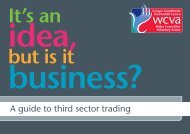Measuring Impact - Nicva
Measuring Impact - Nicva
Measuring Impact - Nicva
You also want an ePaper? Increase the reach of your titles
YUMPU automatically turns print PDFs into web optimized ePapers that Google loves.
32 <strong>Measuring</strong> <strong>Impact</strong> – Case-studies of impact assessment<br />
Interviewees said they felt safer just knowing that activities are being organised for young<br />
people in the area, perhaps highlighting unanticipated impact relating to community safety.<br />
Some projects have a more obvious impact on local residents than others. The type of activities<br />
that by their very nature involve local people (like youth work and arts festivals) will tend<br />
to have a more obvious social impact on local residents.<br />
5.3.4 Partner organisations and added value<br />
The three projects benefited other organisations they collaborate with, or that provide<br />
funding in addition to the SRB funding. Organisations working in partnership with SRBfunded<br />
organisations will benefit by having some of their targets met through their involvement<br />
with regeneration activities. There is a feeling among staff at Lea Rivers Trust that,<br />
being a voluntary organisation, there are particular benefits or added value 10 , that they are<br />
able to offer to the community, as well as to organisations with whom they work in partnership,<br />
and from whom they receive funding. These included engaging with the community on<br />
a much more personal level and involving groups of people that public or private sector<br />
organisations would not otherwise have access to. Other organisations can benefit from this<br />
by funding or working in partnership with a voluntary organisation and tapping into the<br />
added value provided by that organisation.<br />
“Lea Rivers Trust benefits other organisations by allowing them to tap into funds that<br />
they couldn’t reach otherwise.”<br />
– Manager, Lea Rivers Trust<br />
“Because we have the river, we are able to offer conservation groups opportunities that<br />
they might not get on the sites where they normally work.”<br />
– Member of staff, Lea Rivers Trust<br />
There is a feeling though that partner organisations and funders do not fully appreciate the<br />
extent to which they are benefiting, and the added value that results from working with or<br />
funding a voluntary organisation.<br />
“I don’t think they [other organisations] fully recognise the potential that we have to<br />
offer them… we have a unique approach and unique resources and a unique position…<br />
we have much better links with the community… we have volunteers and communities<br />
that are involved in our activities.”<br />
– Member of staff, Lea Rivers Trust<br />
5.3.5 Volunteering<br />
Interviewees felt that volunteering benefited both volunteers and organisations. Benefits<br />
included an opportunity to socialise, the chance to work in a team and gain work-related<br />
skills, and a feeling of making a valuable contribution to the local community or environment.<br />
For the organisation, the opportunity to engage local people in their work and harness<br />
voluntary resources enabled them to achieve otherwise impossible goals. Importantly, volunteer<br />
time was eligible as the organisations’ contribution in a matched-funding applications.<br />
10 Added value is the characteristics or qualities that the voluntary sector is able to offer which are different from the<br />
private or public sectors. This issue will be explored in a forthcoming report on the added value of the voluntary<br />
sector (NCVO, 2003).












